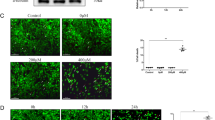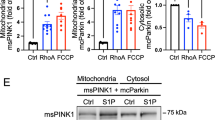Abstract
We investigated cell death during glucose deprivation in rat cardiomyocyte-derived H9c2 cells. Electron microscopic analysis revealed accumulation of autophagic vacuoles during glucose deprivation. The addition of 3-methyladenine or LY294002, which are known to inhibit autophagosome formation, reduced cell death while Z-VAD-FMK, a caspase inhibitor, slightly affected cell death. Thus, cell death during glucose deprivation is not type I programmed cell death (apoptotic cell death) but type II programmed cell death (autophagic cell death). Moreover, we found that both insulin-like growth factor-I and the adenovirus-mediated overexpression of wild-type class I PI 3-kinase accelerated cell death as well as accumulation of autophagic vacuoles during glucose deprivation while dominant-negative PI 3-kinase reduced these phenomena. The results indicate that IGF-I/PI 3-kinase accelerates the accumulation of autophagic vacuoles and subsequent autophagic cell death during glucose deprivation, revealing the opposing role of IGF-I/PI 3-kinase in two distinct types of programmed cell death (apoptotic and autophagic cell death).
This is a preview of subscription content, access via your institution
Access options
Subscribe to this journal
Receive 50 print issues and online access
$259.00 per year
only $5.18 per issue
Buy this article
- Purchase on Springer Link
- Instant access to full article PDF
Prices may be subject to local taxes which are calculated during checkout





Similar content being viewed by others
Abbreviations
- PI:
-
phosphoinositide
- 3MA:
-
3-methyladenine
- Z-VAD-FMK:
-
benzyloxycarbonyl-Val-Ala-Asp-fluoromethylketone
- IGF:
-
insulin-like growth factor
- LC3:
-
microtubule-associated protein 1 light chain 3
References
Aki T, Mizukami Y, Oka Y, Yamaguchi K, Uemura K, Fujimiya T and Yoshida K . (2001). Biochem. J., 358, 481–487.
Anglade P, Vyas S, Javoy-Agid F, Herrero MT, Mitchel PP, Marquez J, Mouatt-Prigent A, Ruberg M, Hirsch EC and Agid Y . (1997). Histol. Histopathol., 12, 25–31.
Arico S, Petiot A, Bauvy C, Dubbelhuis PF, Meuijer AJ, Codogno P and Ogier-Dennis E . (2001). J. Biol. Chem., 276, 35243–35246.
Biederbick A, Kern HF and Elasser HP . (1995). Eur. J. Cell Biol., 66, 3–14.
Blommaart EFC, Krause U, Schellens JPM, Vreeling-Sindelárová H and Meijer AJ . (1997). Eur. J. Biochem., 243, 240–246.
Bursch W . (2001). Cell Death and Differ., 8, 569–581.
Chi S, Kitanaka C, Noguchi K, Mochizuki T, Nagashima Y, Shirouzu M, Fujita H, Yoshida M, Chen W, Asai A, Himeno M, Yokoyama S and Kuchino Y . (1999). Oncogene, 18, 2281–2290.
Clarke PGH . (1990). Anat. Embryol., 181, 195–213.
Fiers W, Beyaert R, Declercq W and Vandenabeele P . (1999). Oncogene, 18, 7719–7730.
Inbal B, Bialik S, Sabanay I, Shani and Kimchi A . (2002). J. Cell Biol., 157, 455–468.
Izuishi K, Kato K, Ogura T, Kinoshita T and Esumi H . (2000). Cancer Res., 60, 6201–6207.
Kabeya Y, Mizushima N, Ueno T, Yamamoto A, Kirisako T, Noda T, Kominami E, Ohsumi Y and Yoshimori T . (2000). EMBO J., 19, 5720–5728.
Katagiri H, Asano T, Inukai K, Ogihara T, Ishihara H, Shibasaki Y, Murata VT, Terasaki J, Kikuchi M, Yazaki Y and Oka Y . (1997). Am. J. Physiol., 272, E326–E331.
Katagiri H, Asano T, Ishihara H, Inukai K, Shibasaki Y, Kikuchi M, Yazaki Y and Oka Y . (1996). J. Biol. Chem., 271, 16987–16990.
Kegal BK, Kim M, Sapp E, McIntyre C, Castãno JG, Aronin N and DiFiglia M . (2000). J. Neurosci., 20, 7268–7278.
Kitanaka C, Kato K, Ijiri R, Sakurada K, Tomiyama A, Noguchi K, Nakagawara A, Momoi T, Toyoda Y, Kigasawa H, Nishi T, Shirouzu M, Yokoyama S, Tanaka Y and Kuchino Y . (2002). J. Natl. Cancer Inst., 94, 358–368.
Kitanaka C and Kuchino Y . (1999). Cell Death and Differ., 6, 508–515.
Klionsky DJ and Ohsumi Y . (1999). Annu. Rev. Cell Dev. Biol., 15, 1–32.
Matsui T, Li L, del Monte F, Fukui Y, Franke TF, Hajjar RJ and Rosenzweig A . (1999). Circulation, 100, 2373–2379.
Munafó DB and Colombo MI . (2001). J. Cell Sci., 114, 3619–3629.
Nishino I, Fu J, Tanji K, Yamada T, Shimojo S, Koori T, Mora M, Riggs JE, Oh SJ, Koga Y, Sue CM, Yamamoto A, Murakami N, Shanske S, Byrne E, Bonilla E, Nonaka I, DiMauro S and Hirano M . (2000). Nature, 406, 906–910.
Nixon RA, Cataldo AM and Mathews PM . (2000). Neurochem. Res., 25, 1161–1172.
Ohsumi Y . (2001). Nat. Rev. Mol. Cell Biol., 2, 211–216.
Petiot A, Ogier-Denis E, Blommaart EEC, Meijer AJ and Codogno P . (2000). J. Biol. Chem., 275, 992–998.
Rameh LE and Cantley LC . (1999). J. Biol. Chem., 274, 8347–8350.
Rodriguez-Viciana P, Warne PH, Vanhaesebroeck B, Gout I, Fry MJ, Waterfield MD and Downward J . (1994). Nature, 370, 527–532.
Schweichel JU and Merker HJ . (1973). Teratology, 7, 253–266.
Seglen PO and Gordon PB . (1982). Proc. Natl. Acad. Sci. USA, 79, 1889–1892.
Seglen PO and Bohley P . (1992). Experientia, 48, 158–172.
Tanaka Y, Guhde G, Suter A, Eskelinen E-L, Hartmann D, Lüllmann-Rauch R, Janssen PML, Blanz J, Figura KV and Saftig P . (2000). Nature, 406, 902–906.
Zakeri Z, Bursch W, Tenniswood M and Lockshin RA . (1995). Cell Death Differ., 2, 87–96.
Acknowledgements
The authors would like to thank Dr Yoshitomo Oka (Tohoku University) for his kind gift of recombinant adenoviruses of wild-type and dominant-negative PI 3-kinases and Dr Tamotsu Yoshimori (National Institute of Genetics) for providing antibodies against LC3. This work was supported in part by grants from the Ministry of Education, Science and Culture of Japan, Yamanouchi Foundation for Research on Metabolic Disorders, The Inamori Foundation, The Kowa Life Science Foundation, Takeda Science Foundation, The Mochida Memorial Foundation for Medical and Pharmaceutical Research, Japan Heart Foundation Research Grant, NOVARTIS Foundation (Japan) for the Promotion of Science, Research Program for Special Promotion of the Venture Business Laboratory, Yamaguchi University, Osaka Cancer Research Foundation, The Old Age Research Foundation of Yamaguchi, and Yamaguchi Industrial Promotion Foundation (for YM).
Author information
Authors and Affiliations
Corresponding author
Rights and permissions
About this article
Cite this article
Aki, T., Yamaguchi, K., Fujimiya, T. et al. Phosphoinositide 3-kinase accelerates autophagic cell death during glucose deprivation in the rat cardiomyocyte-derived cell line H9c2. Oncogene 22, 8529–8535 (2003). https://doi.org/10.1038/sj.onc.1207197
Received:
Revised:
Accepted:
Published:
Issue Date:
DOI: https://doi.org/10.1038/sj.onc.1207197
Keywords
This article is cited by
-
4EBP1 senses extracellular glucose deprivation and initiates cell death signaling in lung cancer
Cell Death & Disease (2022)
-
Blunting TRPML1 channels protects myocardial ischemia/reperfusion injury by restoring impaired cardiomyocyte autophagy
Basic Research in Cardiology (2022)
-
Targeted PI3K/AKT-hyperactivation induces cell death in chronic lymphocytic leukemia
Nature Communications (2021)
-
Influence of partial and complete glutamine-and glucose deprivation of breast-and cervical tumorigenic cell lines
Cell & Bioscience (2015)
-
Inhibition of 6-phosphofructo-2-kinase (PFKFB3) induces autophagy as a survival mechanism
Cancer & Metabolism (2014)



